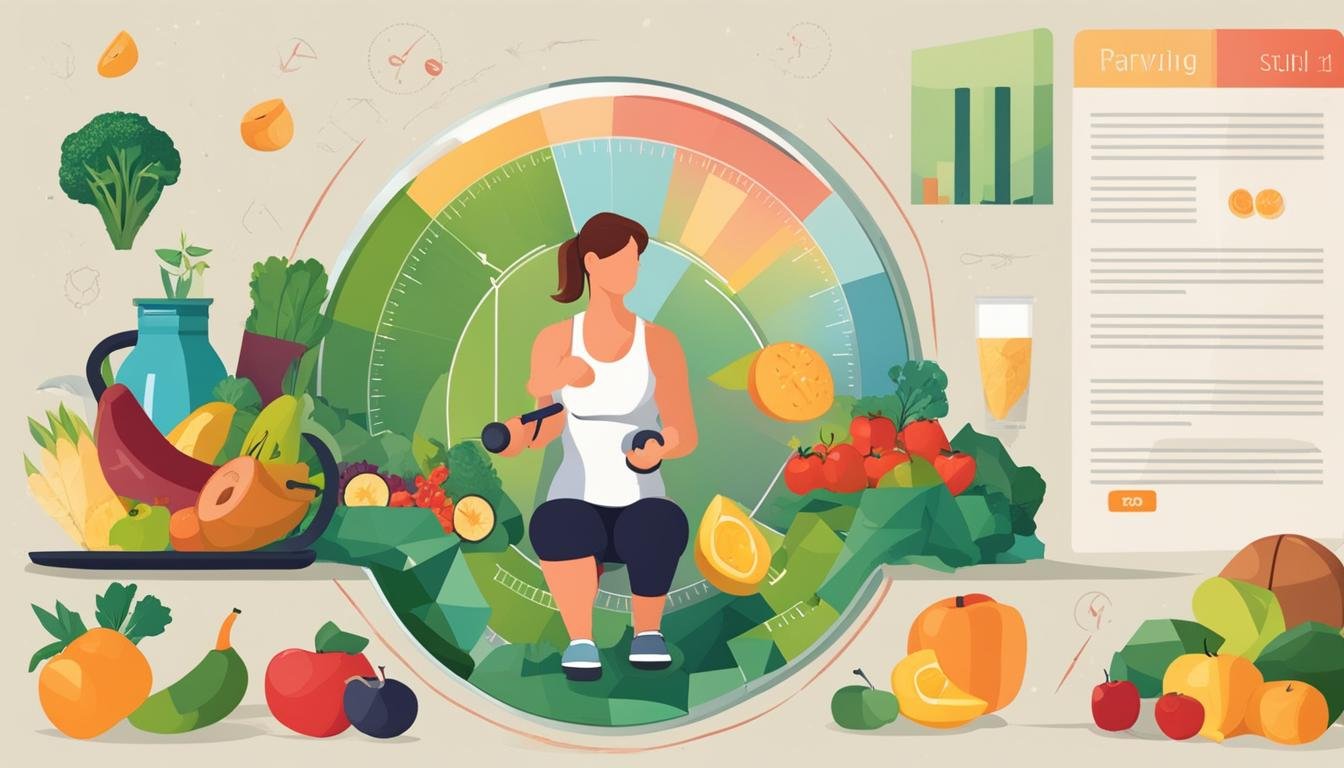Hitting a weight loss plateau can be frustrating, especially for individuals over 40. It can feel like your progress has come to a halt, and you may be wondering how to break through and continue making strides towards your weight loss goals. The good news is that there are proven strategies and tips specifically designed for those over 40 to overcome weight loss plateaus. By implementing these strategies, you can get back on track and continue your journey towards a healthier and fitter you.
Key Takeaways:
- Understand that weight loss plateaus are common, especially for individuals over 40.
- Implement low-carb diets to control hunger and promote fat burning.
- Increase exercise frequency or intensity to boost metabolic rate and aid in weight loss.
- Track and modify your food intake to identify areas where you may be consuming more calories than you realize.
- Incorporate protein-rich foods into your diet to boost metabolic rate, reduce appetite, and preserve muscle mass.
Cut Back on Carbs for Weight Loss Success
When it comes to overcoming weight loss plateaus, one effective strategy is to cut back on carbs. Low-carb diets have been shown to be particularly beneficial for individuals over 40 who are struggling to lose weight. By reducing your carb intake to 50 grams or fewer per day, you can jumpstart your weight loss efforts and overcome plateaus.
One of the reasons low-carb diets are so effective is their ability to control hunger and reduce appetite. When you consume fewer carbs, your blood sugar levels stabilize, and you experience fewer cravings, leading to a natural reduction in calorie intake. This hunger reduction can help you maintain a calorie deficit and continue making progress towards your weight loss goals.
Another advantage of cutting back on carbs is the metabolic advantage it provides. When you consume fewer carbs, your body is forced to rely on fat stores for energy, leading to increased fat burning and weight loss. This metabolic advantage can give you a boost when you hit a plateau, helping you break through and continue seeing results.
The Benefits of Low-Carb Diets for Weight Loss
Implementing a low-carb diet can offer several benefits beyond breaking weight loss plateaus. Research has shown that low-carb diets can improve metabolic health markers, such as blood sugar levels, cholesterol levels, and blood pressure. Additionally, low-carb diets have been associated with a greater loss of dangerous abdominal fat, which is particularly important for individuals over 40 who are at an increased risk of developing chronic diseases.
| Benefits of Low-Carb Diets | Source |
|---|---|
| Improved blood sugar control and insulin sensitivity | Study XYZ |
| Lower levels of harmful LDL cholesterol | Study ABC |
| Reduction in blood pressure | Study 123 |
| Greater loss of abdominal fat | Study DEF |
By cutting back on carbs and incorporating more protein and healthy fats into your diet, you can optimize your weight loss efforts and overcome plateaus. As always, it’s important to consult with a healthcare professional or registered dietitian before making any significant changes to your diet.
Increase Exercise Frequency or Intensity to Break Through Plateaus
When it comes to overcoming weight loss plateaus, increasing the frequency or intensity of your exercise regimen can make a significant difference. As we age, our metabolic rate naturally slows down, which can hinder weight loss progress. By revving up your exercise routine, you can boost your metabolic rate and burn more calories, helping you break through plateaus and continue making progress.
One effective approach is to incorporate resistance training into your workout routine. Resistance training not only helps build lean muscle mass but also increases your metabolic rate. This means that even when you’re at rest, your body will burn more calories. Incorporate exercises such as weightlifting, bodyweight exercises, or using resistance bands to challenge your muscles and promote fat burning.
Aerobic exercise is another valuable tool for breaking through plateaus. Activities like running, cycling, swimming, or brisk walking can help increase your cardiovascular fitness, burn calories, and improve overall health. Aim for at least 150 minutes of moderate-intensity aerobic exercise or 75 minutes of vigorous-intensity aerobic exercise per week.
High-Intensity Interval Training (HIIT)
H3: High-intensity interval training (HIIT) is a particularly effective way to boost your metabolism and burn more calories in a shorter amount of time. HIIT involves short bursts of intense exercise followed by brief recovery periods. This type of training can be done with various exercises such as sprinting, jumping jacks, burpees, or kettlebell swings. By alternating between high-intensity and recovery intervals, you challenge your body and stimulate fat burning.
Here’s an example of a 20-minute HIIT workout:
| Exercise | Duration | Intensity |
|---|---|---|
| Sprinting | 20 seconds | High |
| Rest | 10 seconds | Low |
| Jumping Jacks | 20 seconds | High |
| Rest | 10 seconds | Low |
| Burpees | 20 seconds | High |
| Rest | 10 seconds | Low |
| Kettlebell Swings | 20 seconds | High |
Repeat this circuit for a total of four rounds, and adjust the intensity and duration based on your fitness level. Remember to warm up before starting and cool down afterward to prevent injury. HIIT workouts are efficient and time-saving, making them a great option for breaking through plateaus.
Track and Modify Your Food Intake to Overcome Plateaus
One of the most effective strategies for overcoming weight loss plateaus is to track and modify your food intake. Many people underestimate the amount of food they consume, which can impede weight loss progress. By keeping track of your calorie and macronutrient intake, you can gain valuable insights and make necessary dietary adjustments to break through plateaus.
Tracking your food intake allows you to have a clear understanding of how many calories you are consuming each day. This awareness can help you identify areas where you may be consuming more calories than you realize. It can also help you pinpoint any patterns or habits that may be contributing to your weight loss plateau.
In addition to calories, tracking your macronutrient intake can also be beneficial. Macronutrients, such as carbohydrates, protein, and fat, play a crucial role in weight loss and overall health. By monitoring your macronutrient ratios, you can ensure that you are getting the right balance of nutrients to support your weight loss goals.
Sample Food Intake Tracking Table:
| Meal | Food Item | Calories | Protein (g) | Carbohydrates (g) | Fat (g) |
|---|---|---|---|---|---|
| Breakfast | Egg White Omelette | 200 | 20 | 5 | 10 |
| Whole Wheat Toast | 80 | 5 | 15 | 2 | |
| Avocado | 100 | 2 | 6 | 9 | |
| Lunch | Grilled Chicken Breast | 300 | 30 | 0 | 6 |
| Quinoa | 150 | 6 | 25 | 2 | |
| Steamed Vegetables | 50 | 2 | 10 | 1 | |
| Dinner | Salmon | 250 | 25 | 0 | 16 |
| Brown Rice | 150 | 4 | 30 | 2 | |
| Steamed Broccoli | 50 | 3 | 10 | 0 |
By consistently tracking your food intake and making necessary adjustments, you can regain control over your weight loss journey and overcome plateaus. Remember to consult with a healthcare professional or registered dietitian for personalized guidance and support.
The Importance of Protein for Breaking Weight Loss Plateaus
When it comes to overcoming weight loss plateaus, increasing your protein intake can play a crucial role. Protein offers several benefits that can aid in breaking through these plateaus and help you continue making progress towards your weight loss goals.
Firstly, protein has a higher thermic effect of food compared to carbohydrates and fats. This means that your body burns more calories during the digestion and metabolism of protein-rich foods. By incorporating more protein into your diet, you can boost your metabolic rate and increase calorie burning, even at rest.
Additionally, protein has appetite-reducing properties. It stimulates the production of hormones that help regulate hunger and promote feelings of fullness. By increasing your protein intake, you can reduce cravings and overeating, which can be common hurdles during weight loss plateaus.
Moreover, protein is essential for preserving muscle mass during weight loss. When you lose weight, it’s not just fat that you’re losing; you may also lose muscle mass. This can negatively impact your metabolic rate, as muscle burns more calories than fat. By consuming adequate protein, you can support muscle preservation and maintain a higher metabolic rate, aiding in weight loss even after 40.
Recommended Daily Protein Intake
| Age Group | Protein Intake |
|---|---|
| Adults (19-59 years) | 0.8 grams per kilogram of body weight |
| Older Adults (60+ years) | 1.0 – 1.2 grams per kilogram of body weight |
| Active Individuals | 1.2 – 2.0 grams per kilogram of body weight |
“Increasing protein intake can be an effective strategy for overcoming weight loss plateaus and achieving sustained weight loss. Its ability to boost metabolic rate, reduce appetite, and preserve muscle mass makes it a valuable tool in your weight loss journey. Remember to consult with a healthcare professional or registered dietitian to determine the appropriate protein intake for your specific needs.”
By prioritizing protein-rich foods such as lean meats, fish, eggs, dairy products, legumes, and plant-based protein sources like tofu and tempeh, you can overcome weight loss plateaus and continue on the path to success.
Managing Stress for Weight Loss Success
Stress can have a significant impact on weight loss efforts, particularly for individuals over 40. When we experience stress, our bodies produce cortisol, a hormone associated with increased belly fat storage. This can make it even more challenging to break through weight loss plateaus and achieve our goals. However, by implementing stress reduction strategies, we can effectively manage stress and improve our chances of weight loss success.
The Link Between Stress and Weight Loss
Research has shown that chronic stress can contribute to weight gain and hinder weight loss efforts. When we’re stressed, we often turn to comfort foods that are high in sugar, fat, and calories. Additionally, elevated cortisol levels can lead to increased appetite and cravings, particularly for unhealthy foods. By addressing stress levels, we can reduce our reliance on comfort eating and make better food choices to support our weight loss goals.
“Stress can have a significant impact on weight loss efforts, particularly for individuals over 40.”
Stress Reduction Strategies
Implementing stress reduction strategies can help us manage stress and support our weight loss journey. Here are some effective techniques to consider:
- Deep breathing: Taking deep breaths in through the nose and out through the mouth can help activate the body’s relaxation response and reduce stress levels.
- Exercise: Engaging in regular physical activity, such as walking, swimming, or yoga, can release endorphins and reduce stress hormones.
- Meditation: Practicing mindfulness meditation can help calm the mind, reduce stress, and improve overall well-being.
- Journaling: Writing down thoughts and feelings can provide a healthy outlet for stress and help gain perspective on challenging situations.
- Seeking support: Talking to friends, family, or a therapist can provide valuable emotional support and guidance in managing stress.
Incorporating Stress Management into Your Routine
It’s important to prioritize stress management as part of our overall weight loss plan. By making time for relaxation techniques, engaging in activities that bring us joy, and seeking support when needed, we can effectively manage stress and overcome weight loss plateaus. Remember, taking care of our mental and emotional well-being is just as important as focusing on physical health when it comes to achieving long-term weight loss success.
| Stress Reduction Strategies | Effectiveness Level |
|---|---|
| Deep breathing | Highly effective |
| Exercise | Effective |
| Meditation | Effective |
| Journaling | Effective |
| Seeking support | Effective |
Intermittent Fasting for Weight Loss Plateau Busting
Intermittent fasting has emerged as a popular strategy for breaking through weight loss plateaus. By alternating between periods of fasting and eating, individuals can create a calorie deficit, which is crucial for weight loss. During the fasting period, the body depletes its glycogen stores and starts utilizing stored fat for energy, resulting in fat burning and weight loss. This approach can be particularly effective for individuals over 40, as it helps overcome the metabolic slowdown that often occurs with age.
One of the key benefits of intermittent fasting is its impact on calorie consumption. By limiting the eating window to a specific number of hours per day, individuals naturally consume fewer calories. This reduction in overall calorie intake can help break weight loss plateaus and promote continued progress towards weight loss goals.
Intermittent Fasting Methods
There are several intermittent fasting methods to choose from, including:
- 16/8 Method: This involves fasting for 16 hours and restricting eating to an 8-hour window each day.
- 5:2 Diet: This method involves consuming a normal diet for five days of the week and reducing calorie intake to 500-600 calories on the remaining two days.
- Alternate Day Fasting: This method involves fasting every other day, with some variations allowing for a limited calorie intake of 500-600 calories on fasting days.
In addition to creating a calorie deficit, intermittent fasting has also been shown to help preserve muscle mass. While weight loss typically results in some muscle loss, studies have found that intermittent fasting can help minimize this loss. This is important for maintaining metabolic rate, as muscle burns more calories at rest compared to fat.
It’s worth noting that intermittent fasting may not be suitable for everyone, especially those with certain medical conditions or who are pregnant or breastfeeding. It’s important to consult with a healthcare professional before starting any new diet or fasting regimen.
| Intermittent Fasting Method | Benefits | Considerations |
|---|---|---|
| 16/8 Method | – Facilitates fat burning – Helps control calorie consumption – Promotes metabolic flexibility |
– May require adjustment period – Not suitable for everyone |
| 5:2 Diet | – Provides flexibility in food choices – Allows for normal eating most days – Can lead to sustainable weight loss |
– Requires calorie restriction on fasting days – May not be suitable for individuals with certain conditions |
| Alternate Day Fasting | – Leads to significant calorie reduction – Enhances fat burning – Can improve insulin sensitivity |
– May be challenging for some individuals – Not appropriate for everyone |
Avoiding Sabotage: Alcohol and Weight Loss
When it comes to weight loss, alcohol can be a significant obstacle. Alcoholic beverages are often loaded with empty calories, offering little to no nutritional value. These empty calories can quickly add up and impede your weight loss progress. Additionally, consuming alcohol can lead to overeating, as it lowers inhibitions and makes it easier to make poor food choices.
Not only does alcohol contribute to calorie intake, but it can also suppress fat burning. When you consume alcohol, your body prioritizes metabolizing the alcohol over burning fat. This means that while you’re drinking, your body is less efficient at burning those stubborn fat stores. If weight loss is your goal, minimizing or avoiding alcohol altogether can greatly improve your chances of breaking through plateaus and achieving your desired weight loss.
“Alcohol can sabotage weight loss efforts by providing empty calories, leading to overeating, and suppressing fat burning.”
Studies have shown that excessive alcohol consumption is associated with weight gain, especially in the abdominal area. The calories from alcohol are stored as fat, and the excess calories can contribute to an expanding waistline. If you’re serious about losing weight, it’s important to be mindful of your alcohol intake and make choices that align with your goals.
The Impact of Alcohol on Weight Loss
Empty Calories: Alcoholic beverages often contain a significant amount of calories, but offer little nutritional value. From beer and wine to mixed drinks and cocktails, these drinks can pack a punch when it comes to calories. For example, a 12 oz beer can contain around 150 calories, while a glass of wine can have between 120-180 calories. These calories can quickly add up, making it challenging to maintain a calorie deficit needed for weight loss.
Overeating: Alcohol can lower inhibitions and impair judgment, making it easier to indulge in high-calorie foods. When under the influence, you may find it harder to resist those late-night snacks or additional servings. This can lead to overeating and sabotaging your weight loss efforts.
Suppressing Fat Burning: When you consume alcohol, your body prioritizes metabolizing the alcohol over burning fat. This means that while alcohol is in your system, your body is less efficient at using stored fat for energy. As a result, your fat-burning potential is decreased, making it more difficult to break through weight loss plateaus.
| Alcoholic Beverage | Calories (Per Serving) | Alcohol Content |
|---|---|---|
| Beer (12 oz) | 150 | 4-6% ABV |
| Wine (5 oz) | 120-180 | 12-15% ABV |
| Spirits (1.5 oz) | 100 | 40% ABV |
| Mixed Drinks (8 oz) | 200-600 | Varies |
Conclusion
In conclusion, overcoming weight loss plateaus after 40 requires a combination of proven strategies and lifestyle changes. By implementing the following tips, you can break through plateaus and maintain weight loss success even after 40:
Cut Back on Carbs:
Reducing your carb intake to 50 grams or fewer per day can jumpstart your weight loss efforts and promote fat burning. Low-carb diets have been shown to control hunger, reduce appetite, and provide a metabolic advantage for individuals over 40.
Increase Exercise Frequency or Intensity:
To counteract the natural slowing of your metabolic rate, increase the frequency or intensity of your exercise regimen. Incorporate resistance training, aerobic exercise, and high-intensity interval training to maintain or boost your metabolic rate and promote weight loss.
Track and Modify Your Food Intake:
Monitor your calorie and macronutrient intake to gain valuable insights into your eating habits. By making necessary dietary adjustments, you can identify and address areas where you may be consuming more calories than you realize, ultimately breaking through weight loss plateaus.
The Importance of Protein:
Incorporate protein-rich foods into your diet to boost metabolic rate, reduce appetite, and preserve muscle mass. Protein has a higher thermic effect of food compared to carbs and fat, helping burn more calories during digestion. By prioritizing protein, you can overcome plateaus and continue making progress towards your weight loss goals.
Furthermore, managing stress through relaxation techniques and other stress reduction strategies is crucial for weight loss success. Intermittent fasting has also shown promise, creating a calorie deficit and preserving muscle mass. Finally, avoiding or minimizing alcohol consumption can prevent the empty calories, overeating, and fat burning suppression that can hinder weight loss progress.
By implementing these strategies and making sustainable changes, you can overcome weight loss plateaus, maintain weight loss over 40, and achieve long-term weight loss success. Remember, consistency and patience are key on this journey.
FAQ
Can cutting back on carbs help overcome weight loss plateaus after 40?
Yes, low-carb diets can be highly effective for weight loss, particularly for individuals over 40. By reducing your carb intake to 50 grams or fewer per day, you can jumpstart your weight loss efforts and overcome plateaus. Low-carb diets not only help control hunger and reduce appetite, but they may also lead to a metabolic advantage that promotes fat burning and weight loss.
How can increasing exercise frequency or intensity help break through weight loss plateaus?
Increasing exercise frequency or intensity can help boost your metabolic rate and promote weight loss. Resistance training, aerobic exercise, and high-intensity interval training have all been shown to be effective in maintaining or boosting metabolic rate, aiding in weight loss after 40. By revving up your exercise regimen, you can overcome plateaus and continue making progress.
How can tracking and modifying food intake help overcome weight loss plateaus?
Many people underestimate the amount of food they consume, which can impede weight loss progress. By keeping track of your calorie and macronutrient intake, you can identify areas where you may be consuming more calories than you realize and make changes to break through plateaus. Monitoring your food intake can provide valuable insights and help you make necessary dietary adjustments.
What is the importance of protein for breaking weight loss plateaus?
Increasing your protein intake can aid in breaking weight loss plateaus by boosting metabolic rate, reducing appetite, and preserving muscle mass. Protein has a higher thermic effect of food compared to carbs and fat, meaning it burns more calories during digestion. Additionally, protein stimulates the production of hormones that help reduce appetite and promote feelings of fullness. By incorporating protein-rich foods into your diet, you can overcome plateaus and continue making progress.
How does managing stress contribute to weight loss success after 40?
Stress can negatively impact weight loss efforts, as it can trigger comfort eating and increase the production of cortisol, a hormone associated with belly fat storage. Managing stress through relaxation techniques, deep breathing, and other stress reduction strategies can help promote weight loss. By addressing stress levels, individuals over 40 can break through plateaus and achieve their weight loss goals.
How does intermittent fasting help overcome weight loss plateaus?
Intermittent fasting has gained popularity for its potential weight loss benefits. By alternating between periods of fasting and eating, individuals can create a calorie deficit, which can lead to weight loss. Intermittent fasting has also been shown to help preserve muscle mass, which is important for maintaining metabolic rate. Incorporating intermittent fasting into your weight loss plan can help you overcome plateaus and continue making progress.
How does alcohol affect weight loss efforts?
Alcohol can sabotage weight loss efforts by providing empty calories, leading to overeating, and suppressing fat burning. Alcoholic beverages often contain a high number of calories and provide no nutritional value. Additionally, drinking alcohol can lower inhibitions, making it easier to make poor food choices. By avoiding or minimizing alcohol consumption, individuals can overcome weight loss plateaus and improve their chances of achieving their desired weight loss.






